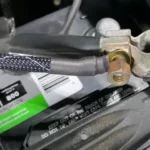There’s been a lot of twist and hoopla about what engine derate is and I’ll explain that later. Let me make a few remarks about the air intake system and how it can reinforce or decrease the performance of your car.
The air intake is one of the components responsible for the emission system of diesel engine derating. It’s integrated basically to allow airflow into your car engine. In our elementary physics, combustion only takes place in the presence of oxygen. The same principle applies to your car engine. Complete engine combustion cannot happen without oxygen in the air.
What does an engine derate mean and how does a poor air intake system cause a derate to happen? We’ll find out in this detailed article.
Engine Derate: What Does it Mean?
A pretty decent air intake system will enable the continuous inflow of air into your engine. With clean airflow, the car will experience superior power output and mileage. However, once the system gets bad, several things could happen. Apart from discontinued airflow, engine derate is another problem you can observe.
Meanwhile, engine derate can be a deliberate modification or design or a consequence of a failed air intake system. Either way, a derate means that your car engine will operate at limited speed or power.
An engine designed to work under normal 20oC can derate to as low as 25% if the ambient temps don’t support it. If, for example, such an engine is operating around 35 degrees Celsius, you can rest assured the derating level will increase. It’s worth saying that your derating car engine performance is relatively normal if its power reduction is between 5-15%. However, when it goes to as low as 25% derating, you’ll need to drive it out for an instant check. A 25% power reduction level isn’t healthy for your engine.
Diesel engine makers integrate this feature into your car as a way of preventing excessive overheating and wearing, while prolonging its lifespan. When this happens, the engine computer program limits the engine from operating at full capacity. They do this to protect against damage to the engine or diesel particulate filter (DPF).
However, when there’s an issue with the air intake system due to aging, poor maintenance, or faulty engine components, your car might experience an engine derate. The emission system is always the problem if the engine derates by 5 mph. The emission mechanism comes with sensors that can trigger derating up to a certain limit.
Furthermore, an engine derate occurs usually when the signs from your car don’t align with the code you’re seeing. The electronic control module (ECM) starts indicating some signs it doesn’t like. Some computers control your car’s ECM and injectors in all mechanical fuel pumps in the diesel engine. The ECM controls the timing of the fuel.
Causes of Air Intake System 25% Derate Problem
The derate features in a diesel engine alongside shutdown or warning. The check engine light is usually a factory warning about certain things not right with your vehicle. A derate means that your check light
Low oil pressure: Another cause of engine derate is low oil pressure. Your diesel engine could experience low oil pressure if the oil bypass valve is open or there’s a restriction in the oil suction tube. Other reasons include improper bearing clearance, low or contaminated engine oil, or faulty oil lines.
High temp: Overheating can lead to engine derating. Where the air filter clogs, your car engine will experience temperatures. As the air filter gets clogged, the inlet air reduces, causing a rich air-fuel ratio. As a result, the engine temp will increase. If you allow the richness to linger, the engine temp will hit a point where engine derating sets in. Diesel Particulate Filter (DPF) code, like P2453, can derate and shut your engine down.
Certain symptoms you may observe are:
- Reduction in maximum power output: A derate usually causes s significant reduction in your engine’s maximum horsepower output. Imagine having a power output of 120 hp from a 350hp engine.
- Drop in vehicle’s speed level: Your car speed can go down to a certain point, up to as low as 50 mph.
- Difficulty in pushing the gas: With engine derating, you may also experience difficulty in pushing the gas.
- Power loss: Power loss is another sign that your engine is derating. You shouldn’t wait until the issue escalates before resolving it.
How to fix Engine Derate Issue
Here are the steps to take to resolve the core issues of engine derating:
- Fix component failures. The first thing to do is to resolve all issues relating to air intake component failure.
- Once done, you can remove any fault codes resulting from derating
- Take the counter back to zero level.
- The engine can attempt a restart to optimal performance
- Reboot the engine three times
- Restore regular configuration
- Confirm if the repair works
- Else, restart the engine within 30 minutes
- Resolve any derating
- Induce engine restart using incentive counter
- Wait for an hour
- Check to see if no faults are detected
If no fault is detected, the vehicle computer will restore normal engine functioning.
Final Thoughts
As we’ve seen, engine derating due to design or modification can be beneficial to your car’s overall life and performance. Maybe you want to read the manual on how to go about engine derating mods. However, engine derating due to a poor air intake system problem can becatastrophic.
While you cannot regulate fluctuating ambient tempts, you can ensure that the air intake system is in perfect condition. This way, you can control engine derating. Never wait until engine derating gets to 10%. You’ll need to be on the lookout for the symptoms and diagnostic code to determine where the problem is. But in all, derating isn’t something to worry about.



